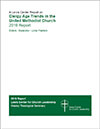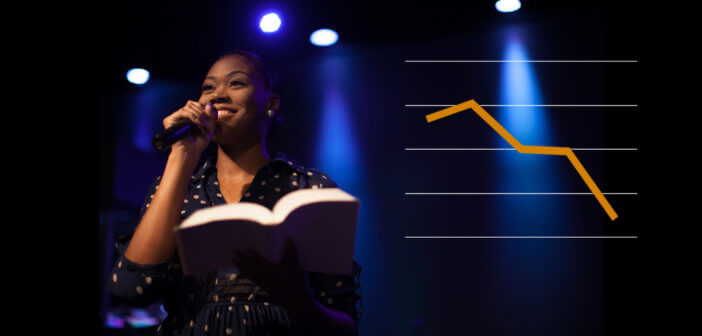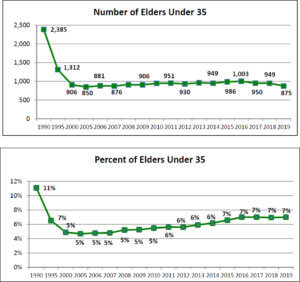Lovett H. Weems, Jr., highlights some of the findings in the Lewis Center’s annual Clergy Age Trends report. Of note is a major downturn in the number of elders under 35. He also identifies the United Methodist conferences that are attracting larger numbers of young clergy.

 Download the 2019 Clergy Age Trends Report.
Download the 2019 Clergy Age Trends Report.
For over 10 years, the Lewis Center in partnership with Wespath Benefits has reported annually on the changing age trends among United Methodist clergy in the United States. This research examines elders, deacons, and local pastors. The 2019 report reveals one major change — a dramatic decline in the number of young elders.
Dramatic decline in the number of young elders
Not only did the number of elders under 35 decline for the third consecutive year, the decline in 2019 is the largest since these reports began in 2005. In addition to the unprecedented size of the decline, another difference is that the losses came proportionately among men and women, while in previous years the losses have come primarily from female elders. The 2019 decline among men means there are fewer male elders under 35 than at any other time for which we have records. Similarly, there are fewer young female elders than any year since 2008.
The number of young elders decreased from 949 in 2018 to 875, a decline of 74. This is the lowest number of young elders since the record low in 2005 when there were only 850 elders under 35.
Young female elders reached a high point in numbers in 2015 with 404. The number in 2019 is down to 325. In terms of their percentage of young elders, the high point was in 2015 at 41 percent. The comparable figure in 2019 is 37 percent.
Interestingly, due to the overall decline in the total number of active elders in the United Methodist Church, the percentage of active elders who are young remains around 7 percent, up from the record low of 5 percent in 2005.
Two skewed clergy age groups
While the number and percentage of middle-aged (ages 35 to 54) United Methodist clergy (elders, deacons, and local pastors) have declined significantly in recent years (from 65 percent of all elders, for example, in 2000 to 37 percent in 2019), it is the one age group that comes closest to matching their presence in the general population: 42 percent of people ages 25 to 72.
On the other hand, the percentage of young clergy (under 35) and the percentage of older clergy (55 to 72) do not reflect the percentage of these age groups in the general population. The percentage of young clergy ranges from 7 percent to 12 percent of all elders, deacons, and local pastors, but 24 percent of the adult population (ages 25 to 72) are under 35.
Just the reverse is true for older United Methodist clergy. People in the 55 to 72 age group constitute 34 percent of the general population but are more highly represented in clergy because from 47 percent to 58 percent of clergy — elders, deacons, and local pastors — are in this age group.
Fewer elders and more local pastors
Elders and local pastors are appointed as pastors of congregations. There has been a major decline in the number of active elders and a dramatic increase in the number of local pastors, a trend already evident in the 1980s. This pattern continues in 2019. Compared to 1990 figures, there are 8,352 fewer elders and 3,627 more local pastors. In 1990, there were over five elders for each local pastor; today there are fewer than two elders for each local pastor.
Other observations
- Of elders, deacons, and local pastors, the group with the highest percent under the age of 35 (12 percent) are deacons.
- The average retirement age in 2018 was 66.2, which is unchanged from the year before.
- The conference that has the highest percentage of young elders (11 percent) is the Texas Conference.
- The conference that has the largest number of young elders is the Western North Carolina Conference (with 50), followed closely by the Virginia Conference (with 49).
It is difficult to know all the causes of the dramatic recent decline in the number of young elders. The reasons are probably many. Current denominational tensions do not help. However, the need to encourage the young to hear and respond to God’s call for their lives, including the called to ordained ministry, is paramount. While clergy of all ages bring distinctive gifts to the practice of ministry, when one age group is significantly lower than their presence in the population, the future is less likely to be positive. With all their limitations of experience, the young see the world and the church through new eyes, bringing enthusiasm, idealism, and fresh perspectives to the practice of ministry. Young clergy are not necessarily better clergy, but they are younger and that matters.

 Download the 2019 Clergy Age Trends Report.
Download the 2019 Clergy Age Trends Report.
Much more information is available in the complete Clergy Age Trends in the United Methodist Church 2019 report, which is available for download free of charge. The full report includes detailed data for every annual conference.
Related Resources
- Clergy Age Trends in The United Methodist Church: 1985-2019
- 5 Reasons the Church Still Needs Young Clergy by Lovett H. Weems, Jr. And Ann A. Michel
- To the Point: Suggestions for Churches with a Young Pastor, a free resource from the Lewis Center








